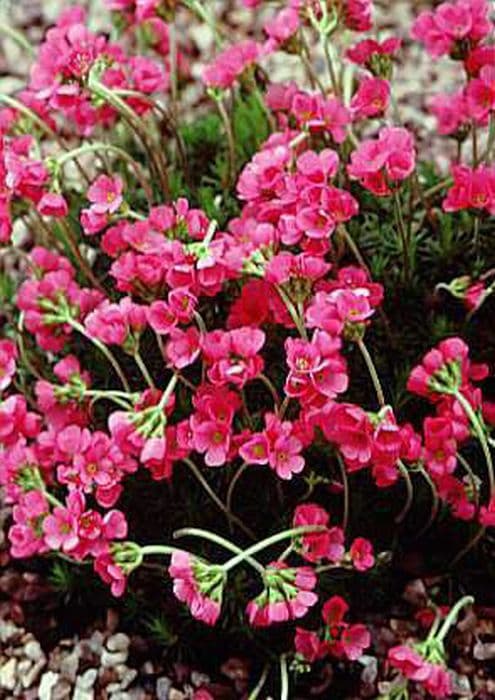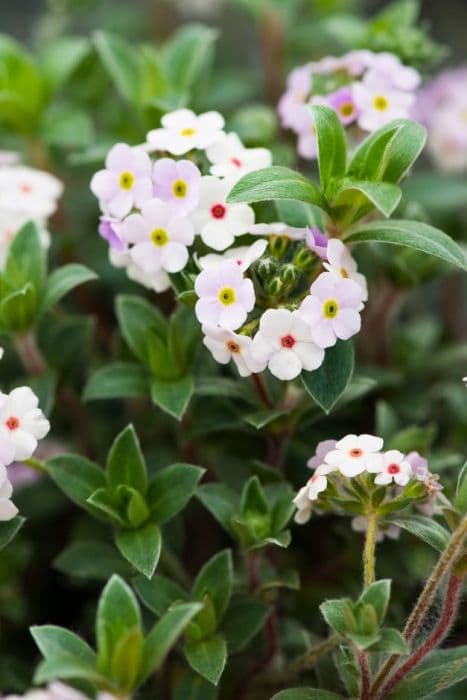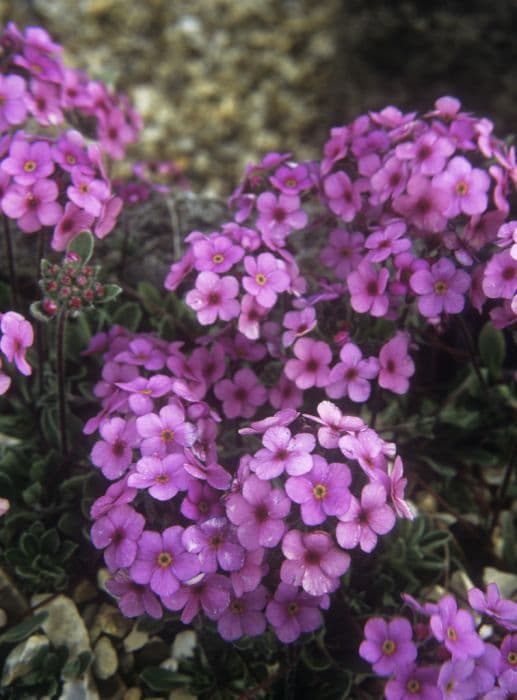Primrose Primula Charisma Series (Pr/prim)

ABOUT
The Primula Charisma Series, also commonly known as polyanthus primroses, are characterized by their vibrant and colorful flowers, which typically display a gradient of hues ranging from rich reds, pinks, and purples to softer yellows and whites. These flowers often have a contrasting yellow center, known as an eye, which creates a striking effect against the colorful petals. The blooms are carried in clusters atop short stems that rise above the rosette of leaves at the base. The leaves of the Charisma Series are crinkly and textured, with a somewhat wrinkled surface that contributes to their lush appearance. The foliage is usually a deep, verdant green, and it forms a basal rosette from which the flowering stems emerge. The rosette shape of the leaves provides a low-growing and attractive ground cover even when the plant is not in bloom. Overall, the Charisma Series of primulas showcases a profusion of eye-catching blooms that create a tapestry of color in garden settings where they are grown. With their lively blossoms and verdant foliage, these plants are often favored by gardeners looking to inject color into shady spots in the garden.
About this plant
 Names
NamesFamily
Primulaceae
Synonyms
Charisma Primroses, Charisma Series Primulas
Common names
Primula Charisma Series.
 Toxicity
ToxicityTo humans
The Primula, commonly known as Primrose, from the Charisma Series, is not typically considered toxic to humans. However, sensitive individuals may experience mild irritation or an allergic reaction if they come into contact with the plant's sap. If ingested, the most likely symptoms are stomach upset, nausea, vomiting, or diarrhea. These symptoms are typically not severe, but if ingestion occurs and any symptoms manifest, it is recommended to consult a medical professional.
To pets
Primrose can be mildly toxic to pets if ingested. Symptoms of Primrose poisoning in pets may include vomiting, diarrhea, and drooling. Contact with the sap can also lead to dermatitis in some animals. If you suspect your pet has ingested Primrose, it is best to consult with a veterinarian to ensure proper care and treatment.
 Characteristics
CharacteristicsLife cycle
Perennials
Foliage type
Evergreen
Color of leaves
Green
Flower color
Varies
Height
6-12 inches (15-30 cm)
Spread
6-12 inches (15-30 cm)
Plant type
Herb
Hardiness zones
5-9
Native area
Europe
Benefits
 General Benefits
General Benefits- Vibrant Colors: Adds a splash of color to gardens with a variety of bright and cheerful hues.
- Early Bloomers: Among the first flowers to bloom in spring, providing early season interest.
- Compact Size: Ideal for borders, containers, and small garden spaces due to their small stature.
- Minimal Maintenance: Requires relatively low care compared to many other perennials, making them suitable for novice gardeners.
- Cold Tolerant: Capable of withstanding cooler temperatures, making them suitable for a range of climates.
- Attracts Pollinators: A source of nectar for bees and butterflies, promoting biodiversity.
 Medical Properties
Medical PropertiesThis plant is not used for medical purposes.
 Air-purifying Qualities
Air-purifying QualitiesThis plant is not specifically known for air purifying qualities.
 Other Uses
Other Uses- Edible Flowers: The blooms of the primrose can be used to decorate salads, desserts, and drinks, adding a touch of color and a mild flavor.
- Natural Dye: The pigments in primrose flowers can be used to naturally dye fabrics or paper, creating soft yellow to green hues.
- Crafting: Dried primrose flowers can be incorporated into potpourri, sachets, or embedded into candles for decorative purposes.
- Ice Cubes: Freeze primrose petals in ice cubes to create an attractive and edible addition to punch bowls or iced drinks.
- Bookmarks: Pressed primrose flowers can be laminated to create unique and attractive bookmarks.
- Scented Stationery: The petals can be infused into water to create a floral-scented spray for papers and envelopes.
- Plant-Based Glitter: Dried and crushed primrose petals can serve as a biodegradable glitter alternative for art projects.
- Garden Borders: Primrose plants can be used to create colorful, low-growing borders along garden paths or flower beds.
- Photography: Primroses provide an excellent subject for macro photography and garden landscapes, adding vibrant colors to the visual composition.
- Teaching Tool: Educators can use primroses to teach students about plant biology, including flower structure and pollination.
Interesting Facts
 Feng Shui
Feng ShuiThe Primrose is not used in Feng Shui practice.
 Zodiac Sign Compitability
Zodiac Sign CompitabilityThe Primrose is not used in astrology practice.
 Plant Symbolism
Plant Symbolism- Young Love: The Primula, also known as the Primrose, is often associated with the concept of young love, representing the excitement and freshness of a new relationship.
- Eternal Existence: With its perennial nature, the Primrose symbolizes eternal existence and the cycle of life, reflecting the idea that life continues in a perpetual loop.
- Hope: The early blooming of Primroses, often in late winter or early spring, makes them a symbol of hope, as they are among the first flowers to emerge after the cold winter months.
- New Beginnings: Their early appearance also signifies new beginnings, representing the start of a new cycle and the potential for growth and renewal.
- Protection: In some folklore traditions, Primroses are thought to provide protection, especially when planted near the home, symbolizing a safe haven or guardian against negativity.
 Water
WaterThe Charisma Series of Primrose should be watered thoroughly when the surface of the soil begins to dry out. A regular watering schedule of once or twice a week is typically sufficient, but always check the soil before adding water. These plants prefer to stay moist but not waterlogged, so ensure good drainage. Each time you water, gently pour enough to uniformly moisten the soil; for a potted primrose, this might be approximately 8-16 ounces depending on the pot size and the soil's dryness. During the growing season, they may require more frequent watering, but less during dormancy.
 Light
LightPrimrose Charisma Series thrive in bright, indirect light. A location with morning sun and afternoon shade is ideal for these plants, ensuring they're not exposed to the intense, direct rays of midday sun. If grown indoors, a north-facing window or an east-facing window with some light filtering is optimal to maintain the vibrant colors of the flowers without causing them harm.
 Temperature
TemperaturePrimrose Charisma Series prefer cooler temperatures, thriving between 50-70°F. They can survive minimum temperatures down to just above freezing; however, they should not be exposed to harsh frost conditions or temperatures below 32°F. These plants are not tolerant of high heat, so ensure they are kept in conditions that do not exceed 80°F.
 Pruning
PruningPrimrose Charisma Series benefit from deadheading spent flowers to encourage new blooms and maintain a tidy appearance. Prune away any yellowing leaves or dead growth as needed. The best time for pruning is immediately after blooming has occurred. Regularly removing dead plant material will help prevent disease and promote vigorous growth for the next flowering cycle.
 Cleaning
CleaningAs needed
 Soil
SoilPrimroses, including the Charisma Series, thrive in moist, well-draining soil rich in organic matter, with a slightly acidic to neutral pH of 6.0 to 7.0. A mix of peat, loam, and sand or perlite works well for potting.
 Repotting
RepottingPrimroses like the Charisma Series should be repotted annually in the early spring before flowering, when they outgrow their current pot or the soil appears exhausted.
 Humidity & Misting
Humidity & MistingPrimroses, like the Charisma Series, prefer a high humidity environment, thriving at humidity levels of 50-60%, which supports their lush foliage and striking flowers.
 Suitable locations
Suitable locationsIndoor
Keep primroses cool, well-lit, and away from heat.
Outdoor
Plant in partial shade, enrich soil, keep moist.
Hardiness zone
4-8 USDA
 Life cycle
Life cycleThe life of a Primrose (Primula Charisma Series) begins with seed germination, which typically occurs in moist, cool conditions. After germination, the seedlings grow into juvenile plants, developing a rosette of leaves at the soil surface. As the plants mature, they enter the vegetative stage, where they continue to grow and produce larger leaves. Following the vegetative stage, primroses enter the flowering phase, characterized by the development of colorful blooms that can be a variety of colors including red, pink, purple, and white, often appearing in late winter to early spring. After pollination, the flowers produce seed capsules containing numerous small seeds, which can be dispersed to start new plants. The life cycle can continue with these new seeds or the plant can propagate vegetatively by dividing the rosette to create new clumps.
 Propogation
PropogationPropogation time
Spring-Early Summer
The Primula Charisma Series, commonly known as Polyanthus primula, is commonly propagated through division, which is an effective method for multiplying these perennials. The best time to divide Polyanthus primula is after they have finished flowering, typically in late spring or early fall. To propagate by division, you should gently lift the plant from the soil and use a sharp knife or spade to slice the clump into smaller sections, each with a section of roots and several leaves. Replant the divisions immediately into well-prepared soil, ensuring they are watered in well and kept moist until they establish. This simple technique allows gardeners to quickly increase their stock of Polyanthus primula while maintaining the genetic consistency of the Charisma Series cultivars.









